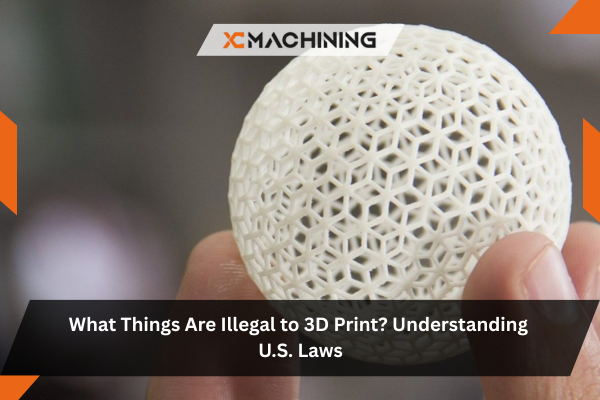3D printing technology has revolutionized how we create objects, from simple household items to complex mechanical parts. This remarkable innovation puts manufacturing power directly into your hands, allowing you to design and produce almost anything imaginable. However, this freedom comes with significant legal responsibilities. Understanding what you cannot legally 3D print protects you from serious criminal charges and helps maintain the integrity of this transformative technology.
Inhaltsübersicht
The Legal Landscape of 3D Printing
3D printing exists in a complex legal environment where federal laws, state regulations, and intellectual property rights intersect. While the technology itself is completely legal, what you choose to create with it can cross into illegal territory. The same printer that produces a replacement part for your kitchen appliance could theoretically create prohibited items—making knowledge of these boundaries essential for every 3D printing enthusiast.
The challenge lies in the fact that 3D printing laws continue evolving as lawmakers struggle to keep pace with rapidly advancing technology. What might seem like an innocent project could inadvertently violate regulations you didn’t know existed. This guide clarifies which items are illegal to 3D print under current U.S. law and explains the reasoning behind these restrictions.
Firearms and Weapon Components: The Most Controversial Territory
Is It Illegal to 3D Print Guns?
The question “is it illegal to 3D print guns?” doesn’t have a simple yes or no answer. Under federal law, manufacturing firearms for personal use without intent to sell is generally legal for individuals who can legally possess guns. However, multiple restrictions and requirements make this area extremely complicated.
Federal requirements for 3D printed firearms include:
- The gun must be detectable by metal detectors (requires metal components)
- You must be legally allowed to possess firearms (no felony convictions, domestic violence restraining orders, etc.)
- You cannot manufacture firearms with intent to sell without a Federal Firearms License (FFL)
- Certain weapon types remain prohibited regardless of manufacturing method
- You may need to serialize the firearm depending on your state’s laws
The Undetectable Firearms Act of 1988 specifically prohibits any firearm that cannot be detected by standard security screening equipment. This means your 3D printed gun must contain at least 3.7 ounces of steel or similar material in specific configurations. A completely plastic firearm violates federal law regardless of who makes it or how.

Is It Illegal to 3D Print a Firearm? State-Level Complications
While federal law provides the baseline, state laws add significant complexity. Some states have enacted much stricter regulations:
States with additional 3D printed firearm restrictions:
Several other states have pending legislation addressing 3D printed firearms. Before considering whether it’s legal to 3D print a firearm in your jurisdiction, research both federal and state laws carefully. Better yet, consult with an attorney specializing in firearms law.
Specific Prohibited Weapon Components
Even if you’re not printing complete firearms, certain weapon components are illegal to 3D print:
Silencers and suppressors: Manufacturing these devices without proper ATF approval and tax stamp payment violates the National Firearms Act. This applies regardless of manufacturing method, including 3D printing.
Machine gun conversion devices: Any part designed to convert a semi-automatic firearm into a fully automatic one is strictly prohibited. The ATF has prosecuted individuals for 3D printing these components.
Short-barreled rifles and shotguns: Components specifically designed to create these NFA-regulated items without proper authorization are illegal.
Bump stocks: Following the 2019 federal ban, manufacturing bump stocks through any method, including 3D printing, violates federal law.
Intellectual Property Violations
Intellectual property law significantly restricts what you can legally 3D print, even in the privacy of your home. These restrictions protect creators’ rights but can surprise hobbyists who don’t realize they’re breaking the law.
Copyright-Protected Designs
Copyright automatically protects original artistic works, including many 3D designs. Printing copyrighted designs without permission constitutes infringement, even for personal use. Common violations include:
- Characters from movies, TV shows, or video games
- Proprietary toy designs and action figures
- Artistic sculptures and decorative items
- Branded logos and symbols
- Architectural models of copyrighted buildings
Many people mistakenly believe that non-commercial, personal use exempts them from copyright law. This is false. While copyright holders rarely pursue individual hobbyists, the law technically prohibits these reproductions.
Trademarked Items
Trademarks protect brand identities, logos, and distinctive product designs. Creating items that could cause consumer confusion about source or affiliation violates trademark law. Examples include:
- Company logos on products you plan to sell
- Replicas of branded products that could be mistaken for genuine items
- Products using protected brand names or slogans
- Counterfeit luxury goods bearing designer marks
Trademark violations become particularly serious when commercial activity is involved. Selling 3D printed items bearing protected trademarks can result in substantial penalties.
Patented Inventions
Patents protect functional inventions and unique designs. Manufacturing patented items without licensing permission infringes on patent rights. This includes:
- Replacement parts for products still under patent protection
- Specialized tools or devices covered by utility patents
- Unique ornamental designs protected by design patents
- Medical devices with active patents
Patent infringement carries severe penalties, including statutory damages that can reach hundreds of thousands of dollars per violation in commercial cases.
Currency and Financial Instruments
Federal law strictly prohibits reproducing U.S. or foreign currency through any means, including 3D printing. This extends beyond obvious counterfeiting attempts to include:
- Coin replicas that could pass as genuine currency
- Paper currency reproductions, even clearly marked as reproductions in some cases
- Credit cards, debit cards, or payment cards
- Government-issued identification cards
- Securities, bonds, or other financial instruments
The Secret Service actively investigates counterfeiting, and penalties include lengthy federal prison sentences. Even creating props for educational purposes or film production requires special authorization.
Prohibited Items and Restricted Goods
Several categories of items are illegal to manufacture through any method, including 3D printing:
Drug Paraphernalia
While laws vary by state, manufacturing drug paraphernalia often violates federal and state laws. This includes pipes, bongs, and other devices primarily intended for illegal drug use. The key factor is intent—if the item’s primary purpose is illegal drug consumption, manufacturing it may be criminal.
Lock Picking Tools
Some jurisdictions restrict or prohibit possession of lock picking tools without legitimate locksmith credentials. Manufacturing these tools with intent to use them for burglary clearly violates the law. Even possession in some states requires proof of lawful purpose.
Regulated Items Requiring Licenses
Certain items require special licenses or permits to manufacture legally:
- Medical devices requiring FDA approval
- Aviation parts without proper certification
- Automotive safety components without compliance testing
- Radio frequency devices without FCC approval
Manufacturing these items without authorization can result in regulatory violations separate from criminal charges.
The Unique Case: Is It Illegal to 3D Print a 3D Printer?
Here’s some good news: is it illegal to 3D print a 3D printer? Absolutely not. In fact, the RepRap project has championed self-replicating 3D printers for years. Printing components for another 3D printer is completely legal and represents one of the technology’s most fascinating capabilities.
Many hobbyists build their own 3D printers using a combination of printed parts, purchased electronics, and mechanical components. This practice is encouraged within the maker community and violates no laws. However, if you’re copying a patented 3D printer design for commercial sale, you could face patent infringement claims.
Safety and Liability Considerations
Beyond explicit legal prohibitions, manufacturing certain items creates serious liability risks:
Products that could cause injury: 3D printing safety-critical items like climbing equipment, car parts, or children’s toys exposes you to product liability claims if they fail and cause harm.
Items requiring engineering standards: Many products must meet specific safety standards. 3D printing replacement parts that fail to meet these standards could result in liability, even if the printing itself isn’t illegal.
Medizinische Geräte: Creating medical devices without proper approval and testing violates FDA regulations and could harm users.
Export Control Violations
Federal export control laws restrict sharing certain 3D printing files internationally. Technical data for defense-related items, including some firearms designs, falls under International Traffic in Arms Regulations (ITAR). Posting these files online where foreign nationals can access them may violate export control laws.
This concern extends to:
- Weapons systems and components
- Advanced manufacturing processes for defense applications
- Encryption technology
- Satellite and spacecraft technology

Best Practices for Legal 3D Printing
Staying on the right side of the law requires vigilance and common sense:
Research before printing: Investigate whether designs you’re considering might violate intellectual property rights or regulatory requirements.
Use legitimate sources: Download designs from reputable platforms that respect intellectual property rights like Thingiverse, MyMiniFactory, or Printables.
Respect licenses: Many 3D printing designs carry specific licenses. Creative Commons licenses, for example, may permit personal use but prohibit commercial applications.
Understand your local laws: State and local regulations add layers beyond federal law. What’s legal in one state might violate laws in another.
When in doubt, ask: Consult with attorneys specializing in intellectual property, firearms law, or regulatory compliance if you’re uncertain about a project’s legality.
The Future of 3D Printing Regulation
Als 3D-Druck becomes more accessible and capable, expect continued regulatory evolution. Lawmakers struggle to balance innovation and public safety while protecting intellectual property rights. Future regulations might include:
- Enhanced tracking of 3D printer purchases
- Required registration for certain types of printers
- Expanded restrictions on sharing certain design files
- New intellectual property frameworks addressing 3D printing specifically
Schlussfolgerung
3D printing offers incredible creative freedom, but this freedom comes with legal responsibility. Understanding what things are illegal to 3D print protects you from criminal charges, civil liability, and regulatory violations. Whether you’re wondering is it illegal to 3D print guns, concerned about copyright infringement, or simply want to ensure your hobby remains lawful, knowledge of these boundaries is essential.
The technology itself is neutral—legality depends entirely on what you create. By respecting intellectual property rights, understanding firearms regulations, and avoiding prohibited items, you can enjoy 3D printing’s benefits while staying firmly within the law. When questions arise, seeking professional legal advice provides clarity and protection for both casual hobbyists and serious makers.
FAQs
Why do I see free gun files online if printing is restricted?
File hosting itself is often legal under free-speech rules, but downloading can violate export or state gun laws.
Are blueprints considered a firearm?
No, but exporting them abroad without a license is a crime.
Can I print parts like grips or sights?
Yes, as long as the part is not the regulated receiver or a pressure-bearing silencer baffle.
What about printing lock-picks or bump keys?
Many states ban lock-picks carried with intent to break in; possession alone can be a misdemeanor.
Is it safe to copy a paid STL I bought?
Only for personal use. Sharing or selling copies breaks copyright and DMCA rules.





